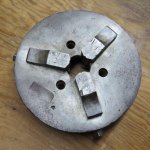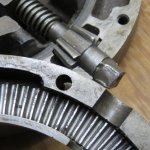Greg, delete this if you don't want for sale items here, but these chucks are old enough most PMer's will have no interest in them over in the F/S section. The first came on an old Sebastian treadle lathe I picked up and the chuck has a 1869 patent date.
It’s 7” OD with a back plate threaded 1.250” – 10. It’s in very good shape except for a ring around the front circumference. At first I thought it was a decorative embellishment but it cut some of the wording off the chuck so that’s not what it is. Lugs are in very good shape. The jaws are marked Patented and 1873. These jaws are a more modern style than the other chuck I’m listing. Operates smoothly.
The 2[SUP]nd[/SUP] chuck, pictures in next post, is also 7” OD with no backplate. Recess on back is 4 7/8" ID. The front has some dings and marks. The lugs have seen some combat. One pinion gear is missing 2 teeth. If you wiggle it, it will pass over the gap OK. It also has a 1869 Patent date. I was going to use this as my practice for gear repair but not anymore.
Both chucks have the right look for an older lathe.
I’m asking $50 for the pair plus shipping in a medium flat rate box.
It’s 7” OD with a back plate threaded 1.250” – 10. It’s in very good shape except for a ring around the front circumference. At first I thought it was a decorative embellishment but it cut some of the wording off the chuck so that’s not what it is. Lugs are in very good shape. The jaws are marked Patented and 1873. These jaws are a more modern style than the other chuck I’m listing. Operates smoothly.
The 2[SUP]nd[/SUP] chuck, pictures in next post, is also 7” OD with no backplate. Recess on back is 4 7/8" ID. The front has some dings and marks. The lugs have seen some combat. One pinion gear is missing 2 teeth. If you wiggle it, it will pass over the gap OK. It also has a 1869 Patent date. I was going to use this as my practice for gear repair but not anymore.
Both chucks have the right look for an older lathe.
I’m asking $50 for the pair plus shipping in a medium flat rate box.

















